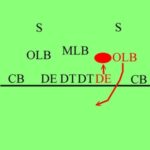“Peripheral vision” is defined as “a part of vision that occurs outside the very center of gaze.” And, “Peripheral vision is good at detecting motion…” And, “Different visual areas contribute to the processing of visual information coming from different parts of the visual field, and a complex of visual areas located along the banks of the interhemispheric fissure (a deep groove that separates the two brain hemispheres) has been linked to peripheral vision. It has been suggested that these areas are important for fast reactions to visual stimuli in the periphery, and monitoring body position relative to gravity” (WikipediA–http://en.wikipedia.org/wiki/Peripheral_vision).
Well…that is certainly a ‘mouthful’, but it’s really just saying that peripheral vision is that gift human beings have been given which allows us to see to either side of us without turning our heads or even moving our eyes. As we know, it is often difficult to determine just what we are seeing with our peripheral vision, but even “detecting motion” is an important factor while driving motor vehicles, for sure!
Using peripheral vision while driving a motor vehicle (or boat, or bicycle, and so on) is one of the most important factors when considering the necessary ingredients for safe, effective “defensive driving”, as peripheral vision allows drivers who learn how to use it well to be aware of as much surrounding activity as possible, which, of course, is critical to safe driving habits.
Using peripheral vision when driving takes a measure of training. That is, in order to fully understand what the peripheral vision is showing, one must learn to process and react to ambiguous or “out-of-focus” visual information. In other words, because peripheral vision is not a direct-on view, our brains are essentially “guessing” a little.
Peripheral vision is a little like looking in the passenger-side outside mirror, where the warning message on the mirror says: “Objects in mirror are closer than they appear”. The warning for peripheral vision might read something like: “Activities in peripheral vision are approximations; view directly for actual details”.
OK…all that said, how do we SAFELY use our peripheral vision when driving?
Once we fully understand that peripheral vision is, indeed, only an approximation of what is actually occurring, we can add peripheral vision to our tool-kit for safe driving (of course, with the understanding that we must verify what we think we are seeing).
We can learn to interpret quite accurately what our peripheral vision is telling us…perhaps even without having to view directly, in some cases…thus allowing us to keep the main focus on the road ahead. Or, perhaps our verification view can be limited to just a quick glance, thereby allowing us to maintain forward-view as much as we can…which is where MOST of the action is, and where our eyes should be most of the time!
With conscious awareness that we are using our peripheral vision as a tool to help us in our safe, defensive driving habits, and by concentrating on training ourselves to clearly understand peripheral vision as a tool and how it must be used, we can become much safer drivers all around (no “pun” intended!).
I think of peripheral vision as an “extended view”, thus extended capability…(providing the information in the peripheral vision is fully understood). I guess it is sort of like some of the high-tech electronic devices which utilize “fuzzy logic”…..where the device is programmed to “guess” at things it doesn’t completely understand, based on parameters built into the logic programming.
We, too, can accomplish the same things; even though we might not see something real clearly in our peripheral vision, we can make enough sense of it to utilize the information accurately and effectively.
Good luck, and “safe defensive driving” using your peripheral vision!



